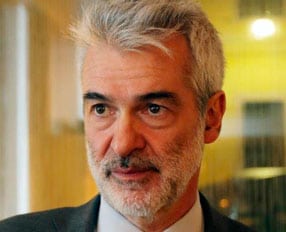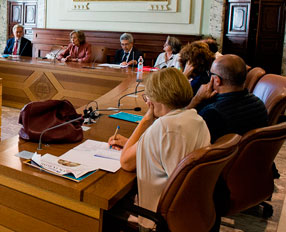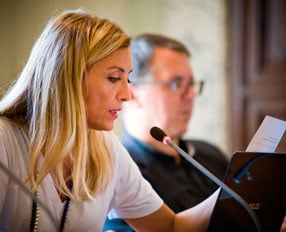He was a correspondent in Teheran (1994-1997 and 2001-2011), Tokyo (1997-2001) and Beirut (2011-2018). He wrote ‘Iran beyond Iran’. Realidades y mitos de un país visto desde dentro’ (2016, second edition expanded and updated in 2017) and ‘Khomeini. God’s Revolutionary” (2018).
The Committee “Journalism and Religious Traditions” (Rome, Italy) counts on the participation of journalists, institutions and exponents of different religious realities (Christians, Jews, Muslims, Hindus, Buddhists, etc.) to promote the understanding of the religious factor in the social context and in public opinion.
The Group is coordinated by the Faculty of Communication of the Pontifical University of the Holy Cross, the Centre for Middle Eastern Studies (Cemo) and the Iscom Association.
What is the general perception of the relationship between the three great religions?
If we focus on the relationship between Islam and the West, the perception, at the media level but often also politically, is that of the clash between two universes. However, this is a stereotype. The data show that in the world after September 11, 2001, Islamic terrorism has been directed more at Muslim countries than at the West. According to data from the Terrorism Index published each year by the Sydney Institute of Politics and Peace, from 2002 to 2018 deaths from terrorism in Europe and North America were 1.1% of the world total, compared to 42% in the Middle East and North Africa, 30% in South Asia (with highly populated Islamic states such as Pakistan and Bangladesh, or with a strong Islamic presence such as India), and 20% in sub-Saharan Africa, which presents the same reality. Even in 2018, 73% of the total number of victims of terrorism are registered in four Islamic countries (Afghanistan, Iraq, Somalia and Syria) and one with an Islamic majority (Nigeria). Terrorism as an attack on the Christian world is therefore a stereotype that is governed by interests of a geopolitical and economic nature. This does not detract from the fact that Christian minorities have felt particularly vulnerable in the storm that has raged in the Middle East in recent decades – which began with the American invasion of Iraq in 2003 – and that those who have been able to get out have preferred to come to Europe, the United States and Canada. The region risks radical change and impoverishment also from the cultural point of view, since these are among the cradles of the oldest Christian communities. I have spoken to many Christians who in recent years have arrived in Lebanon after fleeing from Iraq and Syria. Especially those from the north of Iraq, on the plain of Nineveh, who one day found the letter ‘N’ for Nazarene drawn on their door. A Christian, precisely, whose house can be attacked with impunity. Nasser Jebbo, a refugee who fled with his family and that of his brother from Qaraqosh, occupied by the Isis militia in the summer of 2014, long before the arrival of Isis things had already begun to get bad for Christians. The Jebbos remember that after the fall of Saddam in 2003, pressure gradually grew on Christian women to cover their heads when they went out. Even before the ‘Caliphate’ appeared on the scene, more than half of the 1.5 million Christians living in Iraq had already left the country. An example followed by many Syrian Christians, targets of the Islamist militia in the chaos of the civil war. The best known case is that of the Roman Jesuit priest Paolo Dall’Oglio, who has not been heard from since he disappeared in the summer of 2013 in Raqqa, controlled by Isis. In Syria, according to the Apostolic Nuncio to Damascus, Cardinal Mario Zenari, the percentage of Christians has fallen from 6% of the population before the conflict to 2% at present. In Egypt, the vast Coptic Christian community – about 15% of the population – still fears the establishment of an Islamic religious regime, after the year of government of President Mohammad Morsi of the Muslim Brotherhood, deposed in a coup d’état in 2013 after massive popular demonstrations. With the overthrow of Saddam Hussein’s bloody regime in 2003, and even more so with the Arab Spring of 2011, the media and many Western politicians were carried away by enthusiasm in the superficial belief that Western models of democracy and freedom would automatically take the place of the tyrannical systems that had been overthrown. But no matter how oppressive these regimes are, one must always ask what will take their place once they have collapsed. A problem that has not been raised by the Western powers that have overthrown these regimes over the past 20 years, causing upheaval and suffering no less than the collapse of the Soviet Union, is that the world is not a safe place to live.
However, we must never forget that conflicts are not caused by a clash of religions, but by concrete objectives. This can be understood if we take into account that from a historical point of view the collaboration between Western and Islamic countries, due to different interests, has been and is very frequent. Just think of the support that the United States gave to the Afghan Mojaheddin in the war against the Soviet invaders in the 1980s, and the alliance between the Austro-Hungarian Empire and the Turkish Caliphate in the First World War. Or, going back in time, to the alliance between France and the Ottoman Empire in the 16th century, as opposed to the alliance between the Hapsburgs and the Iranian Safavid Empire. Another example is the position of Iran, a country with an overwhelming majority of Shiite Muslims governed by a religious regime of this denomination, which in the 1990s, during the conflict between Shiite Azerbaijan and Christian Armenia, sided with the latter, mainly because of hostility towards Azerbaijan due to disputes over the division of Caspian oil resources. Similar mechanisms are behind the birth of Isis, a Sunni organization initially viewed with sympathy by the population of this confession that had been marginalized, repressed and exposed to revenge after the fall of the Sunni regime of Saddam Hussein, while Shiite politicians and militias asserted their overwhelming power also thanks to the support of Iran. And it was from Saddam’s inner circle that the military commanders of the ‘Caliphate’ of Abu Bakr al Baghdadi came, who in June 2014 took possession of nearly a third of Iraqi territory in a few days. Soon after, Saddam’s daughter, Raghad Hussein, made it clear how things were: “In Iraq,” she said, “my father’s men are winning. More politics, in short, than religion. Even Ayatollah Khomeini, the symbol of the 1979 Iranian revolution, gave ample evidence of how he used religion to consolidate the power of his faction to the detriment of others who had participated in the uprising against the Shah. To this end, he did not hesitate to oppose and remove from the public scene other prominent Shiite religious leaders, such as Ayatollah Shariatmadari, who, like others of his peers, was against the religious leadership of the state. For decades, the Iranian Khomeini state has managed to assert its power and influence among Shias in several religious countries, particularly Iraq and Lebanon. Although today this denominational ideology appears in crisis in these same countries, with masses of young Shias taking to the streets in protest against corruption and difficult economic conditions, insensitive to the old call of political Islam.
If, therefore, it is economic and geopolitical interests that fuel the wars, why does the perception of the clash of religions persist?
There is a habit, a mental laziness of which many journalists and politicians are guilty, of classifying people belonging to different religions and cultures according to stereotypes. As Edward Said, author of ‘Orientalism’, says, we tend to see the East as a place of adventure, populated by exotic creatures. Any Muslim, therefore, identifies himself not as a human being with his history, his experiences, his doubts, his fears, his joys and his sorrows, that is, like us, but simply as an ‘Islamic being’ whose only concerns are to go to the mosque to pray, to fast during Ramadan, to avoid wine and to respect ritual rules to the letter. An attitude of mind that belongs to those who see Islam as a danger, but also to the representatives of the so-called ‘politically correct’, who want to ban Christmas celebrations in schools because they are convinced that Muslim pupils and their parents could be offended. An attitude that is the result of ignorance. In the two decades I spent in the Middle East I didn’t know a single Muslim who was offended by Christmas trees and cribs, and everyone always wished me well for the holidays. Moreover, Jesus is one of the most important prophets of Islam and Mary is one of the most revered figures by Muslims. Several times in the Koran the Immaculate Conception is also mentioned. Reza, an Iranian friend who did not stop praying daily, did not drink alcohol, and conscientiously observed the fast of Ramadan, asked me one day, while I was on vacation in Italy, to bring him the statues of the manger for his son when he returned. Several times for Christmas the state television of Teheran broadcast a film about Our Lady of Lourdes, and the Iranian presidents never cease to wish the Pope and all Christians luck.
And in any case, no dialogue can be based on the assumption that it is necessary to renounce one’s own religion and culture, because that would be a contradiction. Instead of worrying about cribs and Christmas trees, we would do better to focus on the political motivations that are at the root of much of the mistrust that Eastern peoples have of the West and its colonial past. On any street in Cairo, Baghdad, Beirut or Tehran it is easy to hear the upheavals of the last 20 years in the region explained by the Great Conspiracy Theory. “It is the Americans who have created all this, they want to bring chaos to us in order to prepare a new Sykes-Picot,” said Antoine, a Lebanese lawyer and friend of the Christian faith. Here is the wound that still burns in relations with the West: the secret agreement signed during World War I with which France and Britain decided how to divide the Middle East at the end of hostilities, just as London, through the Lawrence of Arabia, promised independence from the Arabs in exchange for revolt against the Ottoman Empire. There’s enough to fuel mistrust for at least another century. Beware of what jihadist organizations also take advantage of. Among the first declarations issued by Isis after the proclamation of the rebirth of the ‘Caliphate’ in the summer of 2014 was one entitled ‘The End of the Sykes-Picot’, which obviously appealed to the anti-colonialist feelings of the populations of the Middle East. And many years earlier, nationalist sentiments carried a lot of weight, along with economic discontent, in the outbreak of the Iranian revolution in 1979, which later became ‘Islamic’ under Khomeini’s leadership. But there is also another phenomenon that fuels mistrust between the Middle East and the West. Muslims are not afraid of the Christian religion, but on the contrary of Western atheism. Those who have visited Muslim countries up to the 1970s remember that the customs were much more “secular” than they are today. Certain streets in Cairo, Baghdad, Damascus, were not very different from those of a European Mediterranean city. The women covered by the veil were few, beer was drunk on the tables of the open-air bars, the billboards and posters of the movies were almost the same. Then, over the years, these similar realities became polarized to opposite ends. On the one hand, a West in which all the foundations of traditional culture were challenged and in many cases demolished, from religion to political ideologies to the family, with the authority of parents. A world in which sex, especially spoken sex, in advertising, film and the media, became increasingly explicit and obligatory, in the name of (supposed) liberation. On the other hand, an Islamic world that is more and more entrenched in its defensive reaction, more and more (falsely) puritanical because it is afraid of a West that seems only capable of destroying the old rules, but not of proposing new ones to safeguard the foundations of community life. A West that seems to replace the authority of God or the State with that of the individual, with his unlimited rights and his search for unlimited freedom. But also with its loneliness. When I lived in Iran, my work forced me for many years to listen to the sermons of the Supreme Guide, Ayatollah Ali Khamenei, and his denunciations of the “cultural invasion of the West”. However, what is being thrown at Khamenei is not the unfaithful followers of another religion, but a world that has turned its back on religion, on the values of tradition. Obviously this is the possible invasion, the contagion, that is most frightening. The fear to which Khamenei gives voice is that of a disintegration of the world of belonging, which is no longer held together by the cement of rules valid for all. In short, the fear of what the psychoanalyst Massimo Recalcati calls “western nihilism, which is no longer capable of giving meaning to life and death”, after having “demolished all supportive conceptions of existence”. Probably the desire to escape from this nihilism has pushed many young Westerners to join extremist Islam and even to enlist in the Isis, in search, certainly in the wrong place, of reassuring points of reference. A study by the Centre for the prevention of sectarian aberrations in Islam (Cpdsi) is enlightening in this respect. According to the results of the analysis, “subjects raised in excessively tolerant or atheist families” are “more likely to find comfort in messages which, contrary to their family context, provide clear doctrinal rules”.
Response to secular fundamentalism’ is the title of a video message posted on Facebook by Aleppo in 2013 by jihadist Anas al Abboubi, also known as Al Italy, the Italian.
Al Abboubi was a young man of Moroccan origin, but actually Italian, as he had lived in the province of Brescia with his parents since he was 7 years old. Until 2012 he was a rebellious teenager, a rap singer by the name of McKhalif, who spoke with a strong Brescian accent and drank alcohol. Then the conversion, which also made him give up music. After a brief arrest, he fled to Syria and joined the Isis. In his message from Aleppo, the young man calls Western society “perverse and melancholic”, accusing it of individualism, sexual promiscuity, discrimination and little respect for the elderly. According to the two authors who studied his case, Marco Arnaboli and Lorenzo Vidino, this is a real “accusation of the values (or rather the lack of them) of Italian and Western society”.
What can the media do to overcome the schematic and distorted approach to the clash of religions?
Above all, journalists have a duty not to get involved in the emotional waves of the moment, and to try to analyse the facts rationally, always asking themselves what are the reasons and interests, or the nationalist feelings, that lie behind the alleged conflicts of religion and encourage hatred. This requires serious study of the history and geopolitical situation of the region we are dealing with. Unfortunately, this rarely happens, because with every war or outbreak of violence one is immediately overwhelmed, especially in the social media, by an avalanche of bloody messages and images that induce the observer to react simply instinctively, quickly attributing the blame for what is happening to the ‘villain’ in question. This creates a political-media circuit in which everyone intervenes to give their opinion without having any real knowledge of the facts. And without even bothering to find out if the photographs are authentic or, as sometimes happens, are old images reused in completely different contexts. The journalist must never forget his first duty, which is also what distinguishes him as a professional: to verify, as far as possible, every piece of information and every image with which he relates. And, when this is not possible, he must honestly inform his readers. Traveling, and seeing things with your own eyes, is obviously of primary importance to those who can do so. Then you would discover that reality is sometimes very different from how it is shouted in the media. For example, during the demonstrations hostile to the West that took place in recent years in some Muslim countries, such as the publication of cartoons about Muhammad, you would discover that a few hundred, or in some cases a few thousand people, participated in such gatherings in cities of several million inhabitants. Around them, life continued to flow normally, but the cameras focused only on the groups of demonstrators, with the intention of perhaps burning the American flag and the flags of European countries. So the message that was conveyed was that “the world of Islam is rebelling against the West”.
Why is there Islamophobia, anti-Semitism, Christianophobia in the West where there is freedom of religion?
If until 50 years ago contacts between different religions and cultures were limited, the great movement of globalization in recent decades, with the circulation of information and people, has created a terrain for close confrontation. Our societies have not yet taken action and have adapted to these new types of relationships. Moreover, economic globalization has brought, along with its undoubted benefits, many imbalances and new tensions between rich and poor countries. Not to mention the globalization of information, with the possibility of spreading true or false news around the world in a few minutes. According to a sentence attributed to the Nazi regime’s propaganda minister, Joseph Goebbels, a lie once told is a lie, but repeated continuously it becomes a truth. And today’s technologies give the possibility of repeating and making a lie repeat itself a million times. In this situation it is easier to spread feelings of hatred towards anyone who is perceived as different, and over whom one can pass the responsibility for one’s own problems and sufferings. This phenomenon is not fought with slogans, but with a difficult and continuous work of education of the young people that makes them understand how fundamental is the respect of people, which must always be mutual.
People should be respected not because they belong to a particular religion, but as individuals. When you insult a religion – or any deep belief – you are not hurting the “church” of belonging, but the innermost feelings of people of that faith. It is violence against the most cherished part of oneself that each of us has.
And the Middle East – like us – wants to be respected first and foremost as a human being, and not as caricatures of Muslims behind which it is not difficult (even for them) to glimpse a hypocritical condescension with racist veins.
What can the spiritual leaders of different religions do to combat hatred and encourage dialogue?
As I said before, we do not need slogans, but a path of education aimed in particular at young people, which must also be based on facts and concrete examples. In this regard, I would like to mention the many priests and nuns I have seen working in the Middle East, spending themselves for the benefit of all, Christian or Muslim, even in the storm that has hit the region, bringing a threat to the very presence of Christians. Like Father Luciano Burati, 65 years old, 25 of whom spent in Qamishli, in the north of Syria, near the Turkish border, and then moved to Kafrun, near Homs, to run a Salesian house that houses dozens of displaced people from Aleppo. Like mother Annamaria Scarsella, who was ordered to go to Damascus in 2011 to run the ‘hospital of the Italians’, also owned by the Salesians, after 41 years in schools and missions in Mexico, including Chiapas. Like Dutch Jesuit Father Frans van der Lugt, who wanted to be at the side of the sick and hungry in the besieged city of Homs, where he was killed in April 2014. Like Sister Patrizia Guarino of Avellino, a Franciscan of almost eighty years of age who remained in Knayeh in northwest Syria, he fought between Isis and al-Qaeda to run a dispensary where 6,500 sick people were cared for each year. Like those working on the initiative “Open Hospitals in Syria”, wanted by Nuncio Zenari and carried out by the NGO Avsi, which allows free care to be offered to thousands of poor people in two hospitals in Damascus and one in Aleppo.







